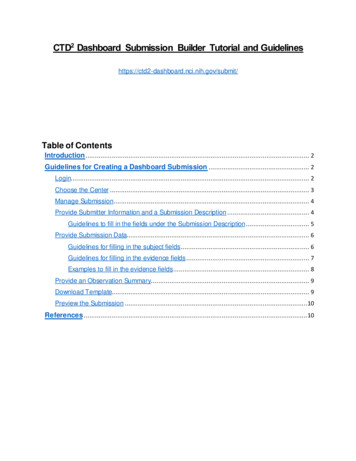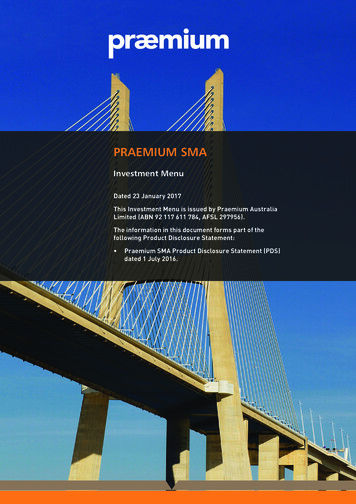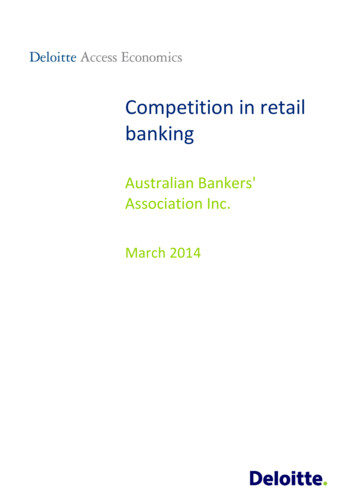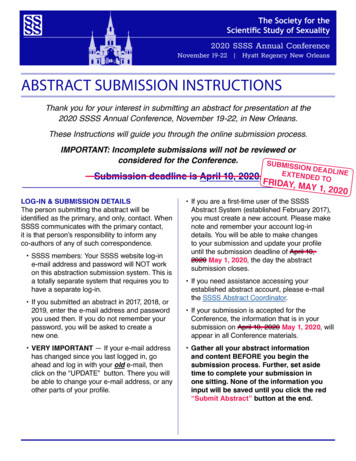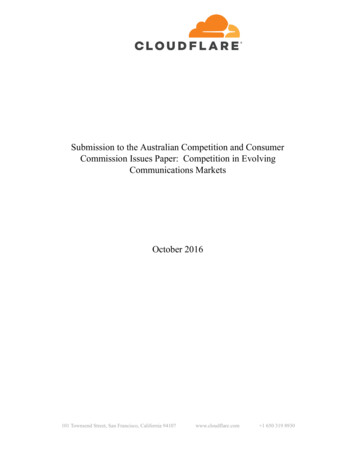
Transcription
Submission to the Australian Competition and ConsumerCommission Issues Paper: Competition in EvolvingCommunications MarketsOctober 2016101 Townsend Street, San Francisco, California 94107www.cloudflare.com 1 650 319 8930
I.BackgroundCloudflare, Inc. (“Cloudflare”) submits these comments in response to the Issue Paper “Competitionin Evolving Communications Markets” put forth by the Australian Competition and Consumer Commission(ACCC). Although the original deadline for submissions was October 14, 2016, Cloudflare requested, and theACCC granted, an extension of time to October 28, 2016 to file this information. Based on communicationinitiated by the ACCC, Cloudflare has agreed to file this description of its experience serving the Australianmarket in order to support the ACCC in its mission of “making markets work for consumers, now and in thefuture,” with regard to internet transmission.Cloudflare is a United States company offering a variety of services to websites to facilitate a faster,more reliable, and more secure Internet. Among other things, Cloudflare offers a global content deliverynetwork that optimizes the loading of customer’s websites for end users. The network also provides securityfor customers’ websites and their visitors by detecting and mitigating online threats such as Distributed Denialof Service attacks, SQL injection attacks, and excessive bot crawling. In order to provide these servicesglobally, Cloudflare procures bandwidth from providers around the world. Cloudflare’s network is powered by100 data centers globally, spanning multiple countries in each continent, and sometimes, multiple cities in eachcountry (including four data centers in Australia: Brisbane, Melbourne, Perth, and Sydney). Cloudflarecurrently serves over 4 million websites. Unlike its competitors, Cloudflare offers a version of its services forfree, enabling any website to benefit from improved speed and security.II.The Importance of Interconnection and PeeringThe Internet operates on the principle of end to end reachability, meaning that any Internet user canreach another Internet user as though they are on the same network, even if they are not. To achieve this,separate and distinct Internet networks must connect to each other in one of two ways: (1) transit, under whichone network pays money to another network to carry its traffic to the whole internet; or (2) peering, underwhich the networks exchange each other’s traffic, including any of both networks’ customers, usuallysettlement free. There are approximately thirteen “Tier 1” networks globally – such as Telia, GTT, and Cogent– who sell transit to access all of the other networks on the Internet using their global backbones, includingnetworks who are not their customers. These Tier 1 Networks are what makes up the “Default Free Zone”(DFZ), wherein no one network is solely responsible for reaching the rest of the Internet. Thus, the Internet isa vast network made up of a collection of smaller networks, which are relatively sparsely interconnected. Infact, of all of these networks, only about 3 percent of the possible direct connections are made.1Peering among separate, autonomous networks is a mutually beneficial arrangement. Thisrelationship reduces costs and latency by allowing the network providers to directly hand off traffic betweenSee, Dennis Weller and Bill Woodcock, “Internet Traffic Exchange: Market Developments and PolicyChallenges”, OECD Digital Economy Papers, No. 207, OECD Publishing (2013), available at:http://dx.doi.org/10.1787/5k918gpt130q en.1101 Townsend Street, San Francisco, California 94107www.cloudflare.com 1 650 319 8930
each other’s customers. It allows them to provide faster, improved performance for their local customers bykeeping traffic local, rather than routing traffic through other, more geographically distant connection points.The networks also gain increased routing control over their traffic flows, a better ability to bypass potentialbottlenecks using additional connection points, and an increased capacity to distribute extremely large amountsof traffic.Despite its youth, the Cloudflare network is quite large and is highly interconnected with othernetworks around the world.2 Given the efficiencies of direct interconnection, it is not surprising thatCloudflare has successfully entered into settlement free peering or reasonable transit pricing relationships withnearly every Tier 1 network, and with regional networks in every part of the world. Cloudflare has an “openpeering” policy, and participates in nearly 150 internet exchanges, in order to facilitate as many of theseefficiency creating connections as possible. However, Australia remains a notable outlier to the rest of theworld, as Telstra and Optus have refused to engage in settlement free peering or reasonably priced transit withCloudflare, even for simply delivering traffic within the country. As explained in greater detail below, this isparticularly inefficient given that such an arrangement would be purely beneficial to Telstra’s and Optus’customers, and would not entail additional cost for Telstra or Optus.III.The Cost of Bandwidth in AustraliaCloudflare’s interconnection and peering arrangements have been essential to its ability to keep its“bandwidth bill” under control. Because of challenges reaching such agreements in the Australian markets,our cost of bandwidth there remain much higher than in the rest of the world. Cloudflare’s cost of bandwidthin Australia is approximately 17 times more expensive than its cost of bandwidth in Europe. In other words, itis more expensive for Cloudflare to serve the 22 million people in Australia than it is to serve the 750 millionpeople across all of Europe. Although Cloudflare peers with other providers in Australia, because Telstra andOptus comprise approximately 50% of the market for Internet service, Cloudflare has not been able tomeaningfully reduce its bandwidth costs for the region. Cloudflare has no other way to send traffic to Telstraand Optus customers who visit websites on the Cloudflare network, and so must pay the high bandwidth pricesdemanded even just for traffic inside the country. We are not aware of any unique feature of the Australianmarket that would make it different from the other countries served by Cloudflare. Given that Australia is onelarge land mass with relatively concentrated population centers, it’s difficult to explain that level of pricingbased on anything other than market power.More detailed information about Cloudflare’s relative costs of bandwidth, highlighting the situation inAustralia, can be found in the blog post “Bandwidth Costs Around the World” from August of this year whichwe have attached to this submission.3IV.23Cloudflare’s Negotiations with Telstra and OptusSee, http://bgp.he.net/AS13335# graph4.The blog post is also available at https://blog.cloudflare.com/bandwidth costs around the world/101 Townsend Street, San Francisco, California 94107www.cloudflare.com 1 650 319 8930
For the past five years, Cloudflare has sought to reach an agreement for more reasonable bandwidthpricing or settlement free peering with Telstra and Optus for traffic within Australia. In a competitive market,such an arrangement would normally benefit both parties by reducing bandwidth costs (transit) and improvingnetwork performance (reduce latency). This is particularly true in the case of Cloudflare because its servicesblock malicious traffic that Internet service providers would otherwise have to carry. However, Telstra andOptus have consistently rejected Cloudflare’s requests to establish a peering arrangement. In contrast, whenCloudflare has approached other providers for peering, agreement has generally been easy to reach given themutual benefits to both parties.V.Impact on Australian CustomersTelstra’s and Optus’ failure to price bandwidth reasonably or to peer harms both their customers andCloudflare’s customers. As a result of the high cost of bandwidth, Cloudflare has moved its free and low pricepoint customers, where possible, off Telstra and Optus to other providers with more reasonable bandwidthpricing. If Telstra or Optus were to peer with Cloudflare, they would only need to move Internet traffic overseveral meters of fiber optic cable within the same data center, between their equipment and Cloudflare’sequipment. As described above, this would be essentially a costless exercise for Telstra or Optus.Instead, under the current arrangement, for a Cloudflare free customer in Australia to reach anotherInternet user in Australia, that traffic must go through data centers in Los Angeles or Singapore via expensiveundersea cables rather than through a local connection point. This results in increased latency, potential packetloss, and degraded performance for the Internet users even though they are geographically in relatively closeproximity to one another. It is also an increased cost for Telstra and Optus, and an inefficient use of resourcesand infrastructure, to port that traffic from Australia, across the world, and back to Australia.To further illustrate this problem, a website operator in Sydney may need improved security and speed forhis or her website, and sign up for Cloudflare’s free or low cost plan in order to better reach his or heraudience. That website operator will experience a slower and potentially less reliable website performancethan a similarly situated operator on Cloudflare’s free or low cost plan in Singapore, all else equal. While theSingaporean operator may reach his or her audience both domestically and internationally by utilizing localInternet peering connections to their greatest effect, thereby ensuring a faster and more reliable experience forthose individuals, the Australian operator will have to deal with greater latency and increased packet loss justto reach the people in his or her local community as well as Australia generally, in addition to individualsabroad. The Australian operator thus faces a structural disadvantage compared to the Singaporean operator inmerely using the Internet.This has even more significant impact for users in Australia who want to use their websites for commercialpurposes, and sign up for Cloudflare to provide greater speed and security for their customer base. A businessowner in Australia on Cloudflare’s free or low cost plan will have slower loading times and increased packetloss in serving his or her customer base, whereas an equally situated business owner in Singapore will not.Australian small businesses are thus at a disadvantage in competing with similar businesses in other countriesto reach and sell to customers via the Internet.101 Townsend Street, San Francisco, California 94107www.cloudflare.com 1 650 319 8930
Furthermore, for an expanding business that aims to sell via the Internet, latency and packet loss becomeincreasingly problematic as the business grows and the number of requests to that website increase. Thisharms small and emerging businesses most of all, as they are far less likely in their initial stages to be able toafford Cloudflare’s higher priced enterprise or business plans, for which Cloudflare can pay the expensivebandwidth prices to move traffic across Australia, or one of Cloudflare’s competitors’ services, which consistof paid enterprise level plans only. As a result, these small and emerging businesses must contend withincreased latency, greater packet loss, and degraded performance that larger, more established businesses canpay to avoid. The lack of local peering connections thus presents a competitive disadvantage to emergingAustralian companies in competing with bigger companies, both domestically and abroad, for Internet sales.Internet users in Australia who are not Cloudflare customers are also negatively impacted. Any user inAustralia who visits any of the millions of websites on Cloudflare’s free or low cost plans will experienceslower loading time and degraded performance in accessing these sites, just because he or she is physicallylocated in Australia. This is true regardless of where the website is hosted even websites whose originservers are in Australia also will have these issues due to Telstra’s and Optus’ failure to locally peer.Cloudflare is not aware of any justification for such an inefficient arrangement. The current systemnegatively impacts Telstra’s and Optus’ own customers and entails a needless use of Internet infrastructure totransmit local traffic.VI.ConclusionThrough unusually high bandwidth pricing in Australia and the absence of agreements by Telstra andOptus to peer with Cloudflare, Australia has become an expensive and inefficient outlier in the market forinternet services. This creates a suboptimal result for Australian website operators and Australians using theInternet. Because we think there are simple, straightforward, and largely standardized ways to remedy thissituation, and alleviate the real harm felt by Australian consumers, Cloudflare supports the efforts of theAustralian Competition and Consumer Commission to undertake this review of Internet interconnection policyand remains available to provide any additional information that may be of assistance.101 Townsend Street, San Francisco, California 94107www.cloudflare.com 1 650 319 8930
10/27/2016Bandwidth Costs Around the WorldBandwidth Costs Around the World17 Aug 2016 by Nitin Rao.CloudFlare protects over 4 million websites using our global network (https://cloudflare.com/network-map) which spans 86cities across 45 countries. Running this network give us a unique vantage point to track the evolving cost of bandwidtharound the world.CC BY-SA 2.0 (https://creativecommons.org/licenses/by-sa/2.0/) image 4667) byQuinn Dombrowski (https://www.flickr.com/photos/quinnanya/)RecapTwo years ago, we previewed the relative cost of bandwidth bandwidth-aroundthe-world/) that we see in different parts of the world. Bandwidth is the largest recurring cost of providing our service.Compared with Europe and North America, there were considerably higher Internet costs in Australia, Asia and LatinAmerica. Even while bandwidth costs tend to trend down over time or-discrepancies-remain/index.html) , driven by competition and sts-around-the-world/
10/27/2016Bandwidth Costs Around the Worldin the costs of underlying hardware, we thought it might be interesting to provide an update.Since August 2014, we have tripled the number of our data centers from 28 to 86, with more to come. CloudFlarehardware is also deployed in new regions such as the Middle East and Africa. Our network spans multiple countries ineach continent, and, sometimes, multiple cities in each country.Traffic across 86 data centers in the CloudFlare networkThere are approximately thirteen networks called “Tier 1 networks” (e.g., Telia, GTT, Tata, Cogent) who sell “transit” toaccess any of thousands of other networks on the Internet using their global backbones, including networks who arenot their customers. We connect to networks by either purchasing transit from a global "Tier 1 dozen-2015-edition/) (or major regional network), or by exchanging traffic directlywith a carrier or ISP using “peering”. Typically, peered traffic is exchanged without settlement between the peeredparties.We try to make it as easy as possible for networks to interconnect with us. CloudFlare has an “open peering” policy, andparticipates at nearly 150 internet exchanges (http://bgp.he.net/report/exchanges# participants) , more than any othercompany.As a benchmark, let's assume the cost of transit in Europe and North America is 10 units (per Mbps). With thatbenchmark in place, without disclosing exact pricing, we can compare regions by transit cost, percentage of peering,and their effective blended cost (transit peering).EuropeEurope Transit vs Peering (Last 30 Days)Based on our benchmark, the transit cost is 10 units. The region has a large number of Internet exchanges, typicallynon-profit, where we peer around 60% of our traffic. This makes for an effective regional cost of 4 units.With perhaps the notable exception of the incumbent in Germany, many networks are supportive of openinterconnection. CloudFlare already participates at 40 European internet exchanges (https://www.peeringdb.com/net/4224) ,and is in the process of joining at least five more.North s-around-the-world/
10/27/2016Bandwidth Costs Around the WorldNorth America Transit vs Peering (Last 30 Days)The cost of transit in North America is equal to the cost in Europe, or 10 units. We peer around 40% of our traffic,resulting in an effective regional cost of 6 units.The level of peering in North America is less than in Europe, but a significant improvement over two years ago. Theshare of peered traffic is expected to grow. Some material changes have occurred and are occurring in the NorthAmerican market, such as Frontier acquiring Verizon FiOS customers tion/) inthree U.S. States and Charter preparing to merge with Time Warner Cable (http://ir.charter.com/phoenix.zhtml?c 112298&p irol-newsArticle&ID 2053012) . We can see these changes making an impact to the regional interconnectionlandscape -few-caveats/) .Notably, our peering has particularly grown in smaller regional locations, closer to the end visitor, leading to animprovement in performance. This could be through private peering, or via an interconnection point such as theMidwest Internet Cooperative Exchange (MICE) (http://www.micemn.net/) in Minneapolis.AfricaAfrica Transit vs Peering (Last 30 Days)Transit prices in Africa are amongst the highest in the world at 14 times the benchmark or 140 units, with notablevariance across the continent, from Cairo (https://blog.cloudflare.com/cairo/) to Mombasa res-43rd-data-center/) to Johannesburg res-30th-data-center/) .Fortunately, of the traffic that we are currently able to serve locally in Africa, we manage to peer about 90% (with a mixof carriers and ISPs), making for an effective cost of 14 units.Our African deployments help us avoid the significant latency of serving websites from London, Paris or Marseille. Aparticularly promising but challenging region where we hope to deploy a CloudFlare data center is West Africa specifically Nigeria, which is already at just under 100 million Internet users -on-the-mobile-internet-as-we-thought/) .Middle round-the-world/
10/27/2016Bandwidth Costs Around the WorldMiddle East Transit vs Peering (Last 30 Days)CloudFlare currently has four data centers in the Middle East, each of which are cache deployments with strategic ISPpartners /) to serve their respective customers. We are able to peer all thetraffic currently served from these data centers. While these collectively provide significant coverage, there is additionaltraffic (reaching Europe) that we would like to localize in the region. We hope that the remaining ISPs, such as SaudiTelecom Company, deploy similar caches, and enhance the performance of their customers.Because we can peer 100% of our traffic in the Middle East, our effective pricing for bandwidth in the region is 0 units.There are, of course, other costs to delivering our service beyond bandwidth. However, by driving up peering rates inthe Middle East we’ve been able to make our service in the Middle East extremely cost competitive.AsiaAsia Transit vs Peering (Last 30 Days)In Asia (excluding the Middle East), transit costs 7 times times the benchmark, or 70 units. However, we peer about 60%of our traffic, resulting in an effective cost of 28 units.Beyond the major meeting points in Hong Kong, Singapore and Tokyo, a significant portion of our interconnection islocalized to take place closer to visitors in cities such as Bangkok (https://blog.cloudflare.com/bangkok/) , -and-new-delhi/) , Kuala laysia-cloudflares-45th-data-center/) , Mumbai -delhi/) , Osaka (https://blog.cloudflare.com/osaka-data-center/) , NewDelhi w-delhi/) , dflares-23rd-data-center/) , and Taipei (https://blog.cloudflare.com/taipei) . These statisticsdo not include our network of strategically located data centers inside of mainland China (https://www.cloudflare.com/china), where the dynamics of interconnection are entirely unique.Two Asian locations stand out as being especially expensive: Seoul and Taipei. In these markets, with powerfulincumbents (Korea Telecom and HiNet), transit costs 15x as much as in Europe or North America, or 150 units.South Korea is perhaps the only country in the world where bandwidth costs are going up. This may be driven by ound-the-world/
10/27/2016Bandwidth Costs Around the Worldregulations from the Ministry of Science, ICT and Future Planning (http://english.msip.go.kr/) , which mandate thecommercial terms of domestic interconnection, based on predetermined “Tiers” of participating networks. This iscontrary to the model in most parts of the world, where networks self-regulate, and often peer without settlement. Thegovernment even prescribes the rate at which prices should decrease per year (-7.5%), which is significantly slower thanthe annual drop in unit bandwidth costs elsewhere in the world. We are only able to peer 2% of our traffic in SouthKorea.If you include HiNet and Korea Telecom in our blended bandwidth pricing, and take into account peering, our effectiveprice is 28 units. If you exclude HiNet and Korea Telecom, our effective price is 14 units.South AmericaSouth America Transit vs Peering (Last 30 Days)Transit prices in South America are very high, costing 17 times the benchmark, or 170 units. We peer about 60% oftraffic in South America, making for an effective cost of 68 units.One of the reasons that transit prices are high is that the Tier 1 networks which are newer entrants to this region haveyet to pick up significant market share. While markets such as Brazil are less expensive and have greater peering, costsare highest in countries such as Peru and Argentina where, in each, a single incumbent provider, respectively Telefonicaand Telecom Argentina, controls access for the last mile delivery of content to the majority of Internet users.As we try to increase our share of peered traffic, one of the challenges we face is that many Internet exchanges (e.g.,NAP Colombia) only permit domestically incorporated and licensed networks to publicly peer, or in another case,require a unanimous vote of all members on an IX to permit a new participant, effectively creating a separationbetween “international content” and “domestic content”.If you include Telecom Argentina and Telefonica, our blended cost of bandwidth in South America is 68 units. If youexclude these two providers then our blended cost is 17 units.OceaniaOceania Transit vs Peering (Last 30 around-the-world/
10/27/2016Bandwidth Costs Around the WorldTransit prices in Oceania (Australia and New Zealand) are lower than they used to be, but continue to be extremely highin relative terms, costing 17 times the benchmark from Europe, or 170 units. We peer 50% of our traffic, resulting in aneffective cost of 85 units.If you exclude Optus and Telstra, then the price falls to 17 units — because we peer with nearly everyone else.Six Expensive NetworksRelative Cost of BandwidthCloudFlare has always optimized where we serve customers to take into account our effective costs. If you are a freecustomer using an excessive amount of expensive transit, we would serve you from fewer regions. The good news isthat, over the last five years, we’ve been able to negotiate reasonable transit pricing or settlement-free peering with thevast majority of the world’s networks. That allows us to continue to provide the free version of our service as well as tokeep prices low for all our paid services.Today, however, there are six expensive networks (HiNet, Korea Telecom, Optus, Telecom Argentina, Telefonica,Telstra) that are more than an order of magnitude more expensive than other bandwidth providers around the globeand refuse to discuss local peering relationships. To give you a sense, these six networks represent less than 6% of thetraffic but nearly 50% of our bandwidth costs.While we’ve tried to engage all these providers to reduce their extremely high costs and ensure that even our Freecustomers can be served across their networks, we’ve hit an impasse. To that end, unfortunately, we’ve made thedecision that the only thing that will change these providers’ pricing is to make it clear how out of step they are with therest of the world. To demonstrate this, we’ve moved our Free customers off these six transit providers. Free customerswill still be accessible across our network and served from another regional cache with more reasonable bandwidthpricing.Ironically, this actually increases the cost to several of these providers because they now need to backhaul traffic toanother CloudFlare data center and pay more in the process. For instance, if Telstra were to peer with CloudFlare thenthey would only have to move traffic over about 30 meters of fiber optic cable between our adjoining cages in the samedata center. Now Telstra will need to backhaul traffic to Free customers to Los Angeles or Singapore over sts-around-the-world/
10/27/2016Bandwidth Costs Around the Worldundersea cables. Their behavior is irrational in any competitive market and so it is not a surprise that each of theseproviders is a relative monopolist in their home market.If you’re a Free CloudFlare customer who cares about optimizing the best possible performance from one of these sixproviders then we encourage you to reach out to them and encourage them to follow a core principle of a free andopen Internet and not abuse their monopoly position. We are committed to serving all our customers across everynetwork that peers with us. To that end, help us convince these six networks to be on the right side of a free and openInternet by reaching out to your ISP.Ask HiNet to peer with CloudFlare in Taipei (http://service.hinet.net/2004/ncsc/index.htm)Ask Korea Telecom to peer with CloudFlare in Seoul (http://www.kt.com/eng/etc/contact.jsp)Ask Optus to peer with CloudFlare across Australia aints-compliments?requestType NormalRequest&id 1409&typeId 5)Ask Telecom Argentina to peer with CloudFlare in Buenos Aires (http://www.telecom.com.ar/hogares/gestion libro.htm)Ask Telefonica to peer with CloudFlare across South America ntact-us)Ask Telstra to peer with CloudFlare across Australia /Email-Complaint)We’ll post updates as we negotiate with these six networks and are hopeful that we’ll soon be able to serve all ourcustomers across all the networks we interconnect with.27 Comments Recommend 10Cloudflare Blog ShareJoin the discussion d-the-world/1 LoginSort by Best
I. Background Cloudflare, Inc. ("Cloudflare") submits these comments in response to the Issue Paper "Competition in Evolving Communications Markets" put forth by the Australian Competition and Consumer Commission


